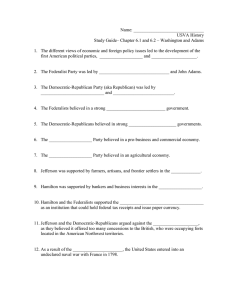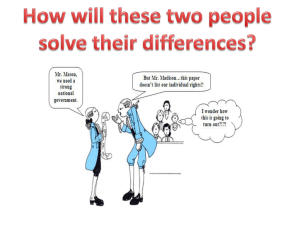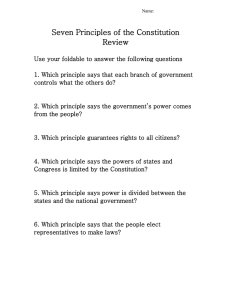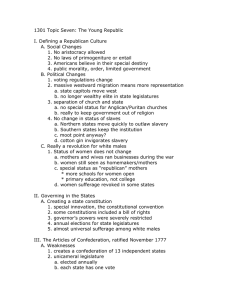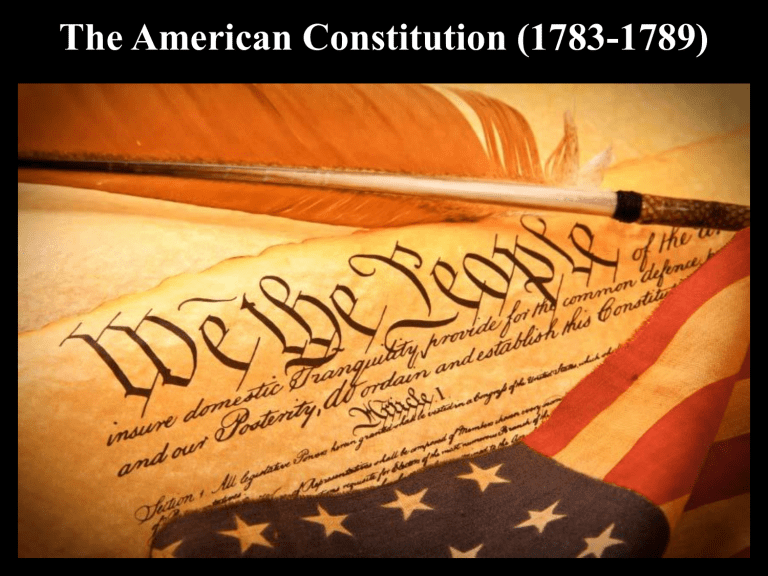
The American Constitution (1783-1789) The degree of one’s understanding of the Constitution is to a large extent the degree of one’s understanding of the United States. ‘The Americans are the first people whom Heaven has favored with an opportunity of deliberating upon, and choosing the forms of government under which they shall live. All other constitutions have derived their existence from violence or accidental circumstances, and are therefore probably more distant from their perfection, which, through beyond our reach, may nevertheless be approached under the guidance of reason and experience.’ John Jay After the Revolutionary War, the United States was ruled by Articles of Confederation, drafted by the Continental Congress. Problems such as the lack of money and debts erupted, and some of the 13 States did not obey the authority of the Congress. And the vision of a "respectable nation" among nations seemed to be fading in the eyes of revolutionaries such as George Washington, Benjamin Franklin, and Rufus King. Their dream of a republic, a nation without hereditary rulers, with power derived from the people in frequent elections, was in doubt. On February 21, 1787, the Confederation Congress called a convention of state delegates at Philadelphia to propose a plan of government. Unlike earlier attempts, the convention was not meant for new laws or piecemeal alterations, but for the "sole and express purpose of revising the Articles of Confederation". The convention was not limited to commerce; rather, it was intended to "render the federal constitution adequate to the exigencies of government and the preservation of the Union." On May 14th, 1787, the Convention officially opened. It was the crowning of the American Revolution. The members were not a random group, but the cream of the revolutionary leadership. George Washington was promptly and unanimously elected President of the Convention for he was a war hero. They agreed in the principle that the remedy for this infirmity was to set up a strong national government consisting of a supreme Legislature, Judiciary, and Executive. The constitution was built on the ideas of: • Federalism: A dynamic combination of nationalism and localism in order to preserve freedom, equality, peace and prosperity. • Separation of Powers: Legislative, Judiciary, Executive • Checks and Balances: Each power checks the other two powers so that no power overpowers the others or abuses its authority. • Covenant: Since the early settlement by the Puritans, covenant ideas formed a significant part of the foundation of the USA around laws. During the four years when the Constitution was prepared and discussed, Federalists two political entities (pro-constitutionalists and emerged for a :the strong centralized government) and the anti-Federalists (for freedom of States rather than for a centralized federal government) . They would later develop into political parties . The anti-Federalists insisted on including a chapter preserving individual freedoms. The latter was known as the Bill of Rights and it consisted of 10 amendments. Federal Government Powers of Each Branch The Principles of Separation of Powers and Checks and Balances • Click here for an explanatory video: https://lawshelf.com/shortvideoscontentview/ the-american-system-of-governmentseparation-of-powers/ Click here for the full text of the Constitution: https://constitutioncenter.org/media/files/con stitution.pdf The Constitution as it emerged between (1787-1791) crowned the American Revolution and provided a safe compass for the future. In theory, it settled all those problems, whether of taxation, of foreign relations, of collective duties and individual rights, of political and legal organizations, which had proved so intractable that they had brought about the downfall of the Old British Empire. It strongly resembled the old order to which Americans, as inheritors of English traditions and settlers in a wilderness, were accustomed, but it had eliminated from that order all those features which seemed obsolete or unjust in the New World. The political thought on which it was based was realistic, accepting that men were not angels, but that their aspirations were mostly legitimate, and it was the business of the political framework to give them scope. Liberty and the rule of law were its two inescapable guiding lights; as understood by the Founding Fathers they have served America pretty well. One thing, the Constitution could not provide of itself: permanence. The world- not just America- was on the brink of an age of tumultuous change of accelerated evolution Biographies of Some Influential Figures of the American Revolution and Constitution George Washington (1789-1797) George Washington (1732-1799), American soldier and politician, was the first President of the United States (under the Constitution of 1787), and he is considered as the Father of the country. Born in Virginia, in the tobacco plantation of a reasonably wealthy family, he worked as a surveyor and, during the French and Indian War of 1754-63, rose to rank of Colonel in the Virginia Regiment. His patriotic spirit and military knowledge acquired during that war meant that, when the Continental Army was organized in 1775, the delegates assembled in Congress decided to elect him as its commander-in-chief. His strategy on the battlefield and his ability to negotiate effectively with his own revolutionary colleagues, allowed him to bring about the eventual defeat of the British army in 1781. After the peace treaty with Great Britain was signed in 1783, George Washington resigned his military post and returned to his plantation in Virginia. When the Constitutional Convention was organized in 1787, Washington was first elected one of the Virginia delegates, and then was unanimously chosen President of the Convention. After the ratification of the new Constitution in 1789, George Washington was elected, again unanimously, the first President of the United States of America and then reelected for the following term. Washington did not run for a third term alleging that, as he explained in his farewell address, “every day the increasing weight of years admonishes me more and more that the shade of retirement is as necessary to me as it will be welcome.” His example was one of the reasons adduced in the 20th century to limit to two the Presidential terms. Thomas Paine Thomas Paine (1737-1809) was a writer, pamphleteer and American revolutionary. Born in England, he is famous especially for his pamphlet Common Sense, published in January 1776, in which he vehemently urged the colonies to separate from Great Britain. For his contribution toward the independence of the United States, Paine is considered one of its Founding Fathers. Paine migrated to America in 1774, and immediately joined the American revolutionaries. In 1777, he was appointed Secretary of the Committee on Foreign Affairs of the Continental Congress, but because of his indiscretions he was expelled from the Committee two years later. Nevertheless, in 1781 Paine participated in a mission to France to get finance for the newly formed Union in their war of independence, and returned to the United States with a grant of several million pounds sterling. Congress rewarded Paine with $3,000 for his services. In 1787, Paine returned to England, and two years later he moved to France to participate in the French Revolution. In spite of not speaking the language, in 1792 he was elected as deputy to the French National Convention. The next year, right in the middle of the Reign of Terror, Paine was arrested and narrowly escaped the guillotine. In 1802 he returned to the United States, remaining there until his death. John Adams (1797-1801) John Adams (1735-1826) was an attorney and American politician, second President of the United States and one of the Founding Fathers. He was born in Massachusetts and graduated from Harvard College. After studying law in the office of a prominent local lawyer, he was admitted to the Bar in 1758. In 1765 he played an active role in the protests against the Stamp Act. Elected to the legislative assembly of the Massachusetts Colony in 1774, he later became one of its delegates to the Continental Congresses. John Adams was part of the committee that drafted the Declaration of Independence. In 1779, Adams and James Bowdoin drafted the text of the Massachusetts Constitution. Adams was one of the American delegates who, in 1782, negotiated the Peace Treaty with Great Britain. Subsequently, he was named Ambassador, first to The Netherlands and then to Great Britain. These assignments prevented him from participating in the drafting of the federal Constitution. John Adams was elected Vice-President in the two presidential terms of George Washington. After Washington’s decision not to run for a third term, John Adams was elected President in 1796 as the candidate for the Federalist Party. In the forthpresidential elections, of 1800, John Adams was defeated by the candidate of the Democratic-Republican Party, Thomas Jefferson, whereupon Adams retired from politics and moved to Massachusetts, dying the 4th of July of 1826, the same day as Thomas Jefferson did. Benjamin Franklin Benjamin Franklin (1706-1790) was an American politician, diplomat, publisher, inventor, musician and writer. Born in Massachusetts, within a humble family, he was self-taught, since he had to leave school at the age of 10 years because his father could not pay the teacher. Franklin worked first as a printer apprentice. At the age of 17, he ran away to Philadelphia and then migrated to London, where he worked as a typesetter. After returning to Philadelphia, at age 21 he started The Pennsylvania Gazette, and at 25 he created the Library Company of Philadelphia. Although he never patented any of them, several inventions are attributed to Franklin, such as the lightning rod and the bifocal lenses. In 1751, Franklin was elected as Representative to the Pennsylvania Assembly and, three years later, he was part of the delegation sent to Albany, where he presented his Plan of union of the colonies. In 1765, Pennsylvania colonists sent him to London, to sue William Penn’s heirs for the proprietorship of the colony, returning to America ten years later, when the Lexington and Concord battles had already been fought. As a delegate to the Second Continental Congress, Franklin was part of the committee that drafted the Declaration of Independence. In 1776, he was sent as the Ambassador to France of the newly independent states, remaining there until 1785. After coming back from that post, he was elected President (governor) of Pennsylvania, an office he held until 1788. In 1787, Franklin was one of the delegates for Pennsylvania to the Constitutional Convention in Philadelphia, but owing to his age and medical condition, his participation was mainly testimonial. Some 20,000 persons attended his funeral in 1790. Thomas Jefferson (1801-1809) Thomas Jefferson (1743-1826) was an American erudite, politician, diplomat, and statesman, and 3rd President of the United States. Born in one of the most influential families of Virginia, in 1762 he graduated in Laws from the College of William & Mary, establishing a prosperous law practice. In 1769, Jefferson was elected as a Representative to the House of Burgesses, and in 1774 drafted several resolutions against the Coercive Acts passed by the British Parliament. Elected in 1775 as one of the delegates to the Second Continental Congress, in 1776 he was the main drafter of the Declaration of Independence. From 1779 to 1781, Jefferson was the governor of Virginia, and in 1784 he was sent as Ambassador to France, where he remained until 1789, not being able to participate in the Constitutional Convention. George Washington, in his first term as President, appointed Jefferson Secretary of State. From 1797 to 1801, during the presidential term of John Adams, Jefferson was elected Vice-President. The main candidate of the Democratic-Republican Party, Jefferson won the Presidential election of 1800, serving two terms, until 1809. During his Presidency, the United States carried out the “Louisiana Purchase” from France. Jefferson organized the Lewis and Clark transcontinental expedition. Almost bankrupt as a result of the poor administration of his estate, in 1815 Jefferson sold his library of more than 6,000 volumes to the Library of Congress, to replace the books that had been burned by the British during the War of 1812. Jefferson died the 4th of July of 1826, a few hours before John Adams did. James Madison James Madison (1751-1836) was an American politician and 4th President of the United States (1809-1817). Born in Virginia, he graduated in 1771 from the College of New Jersey (nowadays Princeton University). Elected in 1776 to the Virginia House of Burgesses, Madison contributed to the drafting of the Virginia Constitution. In 1777 he was elected a member of the governor’s Council, where he met Thomas Jefferson, developing a profound friendship with him. In 1780 he was elected delegate to the Continental Congress, taking side with those proposing a strong central government. In 1787 he was part of the Constitutional Convention of Philadelphia. Madison is considered the father of the Constitution because of his major advocacy of its principles. Madison also drafted the Bill of Rights and wrote several of The Federalist papers in support of the Constitution. In 1790 he organized, with Thomas Jefferson, the Democratic Republican Party. During his appointment from 1801 to 1809 as Secretary of State, he was the defendant in the Marbury v. Madison case, in which Chief Justice John Marshall stated the constitutional doctrine of the judicial review. In 1808 he was elected President of the United States, and during his mandate declared the War –of 1812– against Great Britain, in which British troops captured the federal capital, Washington, DC, and burned down the Capitol and the White House. After his second term, James Madison retired from politics and became a farmer. Alexander Hamilton Alexander Hamilton (1755?-1804) was an American lawyer, soldier, banker and politician. Born in the British colony of Nevis Island, in the Caribbean, he was sent to study at King’s College (now Columbia University), where he graduated in a single year. When the American Revolution started, Hamilton joined the American troops and shortly after became George Washington’s aide. In 1782 he was elected delegate for New York to the Continental Congress. The following year, after three arduous months of self-tuition, Hamilton was admitted to the New York Bar, where he practiced law very successfully. In 1784 he founded the Bank of New York (the oldest American bank in operation today). In 1786 Hamilton went to the Annapolis Convention where he met James Madison, contributing to the report sent to Congress by the latter. Hamilton was one of the delegates to the Constitutional Convention, contributing to it significantly. During the ratification process, Hamilton wrote most of the essays of The Federalist. George Washington appointed him Secretary of the Treasury, though he felt obliged to leave that office in 1795, as a result of an adulterous affair. As one of the leaders of the Federalist Party, in 1804 Hamilton campaigned bitterly against Aaron Burr, with whom he had a personal vendetta. Burr challenged him to a duel in which Hamilton was mortally wounded. Thank you!
